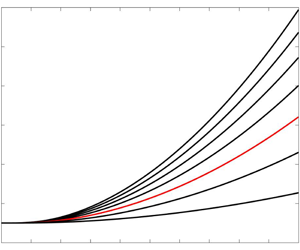Article contents
Low-order Boussinesq models based on  $\unicode[STIX]{x1D70E}$ coordinate series expansions
$\unicode[STIX]{x1D70E}$ coordinate series expansions
Published online by Cambridge University Press: 01 June 2020
Abstract

We derive weakly dispersive Boussinesq equations using a  $\unicode[STIX]{x1D70E}$ coordinate for the vertical direction, employing a series expansion in powers of
$\unicode[STIX]{x1D70E}$ coordinate for the vertical direction, employing a series expansion in powers of  $\unicode[STIX]{x1D70E}$. We restrict attention initially to the case of constant still-water depth
$\unicode[STIX]{x1D70E}$. We restrict attention initially to the case of constant still-water depth  $h$ in order to simplify subsequent analysis, and consider equations based on expansions about the bottom elevation
$h$ in order to simplify subsequent analysis, and consider equations based on expansions about the bottom elevation  $\unicode[STIX]{x1D70E}=0$, and then about a reference elevation
$\unicode[STIX]{x1D70E}=0$, and then about a reference elevation  $\unicode[STIX]{x1D70E}_{\unicode[STIX]{x1D6FC}}$ in order to improve linear dispersion properties. We use a perturbation analysis, suggested recently by Madsen & Fuhrman (J. Fluid Mech., vol. 889, 2020, A38), to show that the resulting models are not subject to the trough instability studied there. A similar analysis is performed to develop a model for interfacial waves in a two-layer fluid, with comparable results. We argue, by extension, that a necessary condition for eliminating trough instabilities is that the model’s nonlinear dispersive terms should not contain still-water depth
$\unicode[STIX]{x1D70E}_{\unicode[STIX]{x1D6FC}}$ in order to improve linear dispersion properties. We use a perturbation analysis, suggested recently by Madsen & Fuhrman (J. Fluid Mech., vol. 889, 2020, A38), to show that the resulting models are not subject to the trough instability studied there. A similar analysis is performed to develop a model for interfacial waves in a two-layer fluid, with comparable results. We argue, by extension, that a necessary condition for eliminating trough instabilities is that the model’s nonlinear dispersive terms should not contain still-water depth  $h$ and surface displacement
$h$ and surface displacement  $\unicode[STIX]{x1D702}$ separately.
$\unicode[STIX]{x1D702}$ separately.
- Type
- JFM Rapids
- Information
- Copyright
- © The Author(s), 2020. Published by Cambridge University Press
References
- 3
- Cited by


